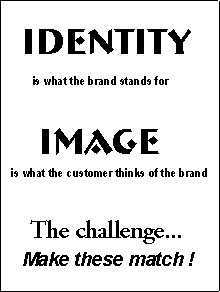What is Marketing?
Marketing is the satisfying of market needs through your product at a profit.
Market needs are, in turn, governed by the customer. The central role of the customer is summed up by Peter Drucker :
“It is the customer who determines what a business is. It is the customer alone whose willingness to pay for a good or a service converts economic resources into wealth, things into goods. What a business thinks it produces is not of first importance - especially not to the future of the business and to its success. The typical engineering definition of quality is something that is hard to do, is complicated and costs a lot of money! But that isn’t quality; it’s incompetence. What the customer thinks he is buying, what he considers value, is decisive - it determines what a business is, what it produces, and whether it will prosper. And what the customer buys and considers value is never a product. It is always utility, that is, what a product or service does for him.”
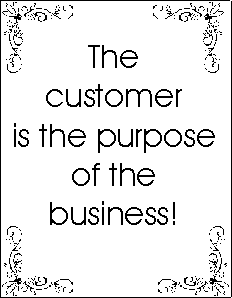
Markets and Segments
The pharmaceutical market is unique in that the actual purchase of a product by the patient is influenced, perhaps dictated, by a third (more knowledgeable) person - the doctor. Thus, the doctor is of paramount importance to the pharmaceutical marketeer, and in fact, is the main customer. Generally speaking, the number of product units sold will be proportionate to the number of prescriptions made by the doctor.
The total number of product units sold will constitute the total market, but a more accurate idea of the the market for a specific product may be obtained through segmentation, which redefines the market into groups of users with similar needs.
Thus we may evaluate the respiratory products segment vis-a-vis gastrointestinal products, or we could further segment respiratory products into antiasthmatic and others, or even check out inhalers versus oral preparations. In this manner, it is possible to define the our market expectations in terms of customer needs and product benefits.
The pharmaceutical market is also unique in its reliance on person-to-person communication rather than mass media as the main thrust of the marketing effort. Thus the pharma salesperson, through whom most communications to the customer are channelised, can make or break the marketing strategy. Skilled field staff are definitely an asset.
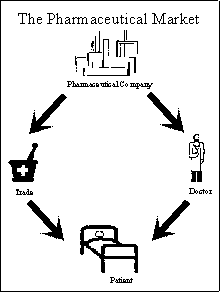
SWOT Analysis
A SWOT (Strengths-Weaknesses-Opportunities-Threats) Analysis is an excellent way to evaluate markets and products. You can do a SWOT Analysis for yourself too! Strengths : Capitalise on strengths Weaknesses : Recognise weaknesses Opportunities : Make the best of available opportunities Threats : Take care of possible threats Make lists of Opportunities and Threats in your market(s), and your product’s Strengths and Weaknesses.
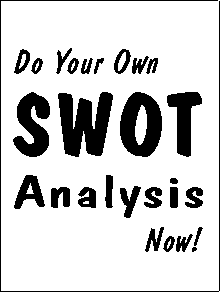
Market Research
Market research provides information about markets. On a day-to-day level, information about the market can be obtained through feedback from chemists and doctors. However, market research with a sound methodology will provide information that is generally more reliable.
Market Research may be (i) Standard (ii) Customised
Standard Market Research reports for the pharmaceutical industry are provided with a fixed periodicity by market research organisations such as ORG, IMS and C-Marc. These include
a) Sales Audit : Retail Store Audit by ORG indicates purchases at the retail level. IMS Reports are generated from Stockists’ sales data. With either of these reports, it is possible to evaluate market potential, product performance vis-a-vis competitors and evaluate trends both all-India and regionally.
b) Prescription Audit : C-Marc and ORG provide data on doctor prescriptions, including frequency of prescriptions of various evaluated products, disease conditions in which the products are used and concurrent prescribed medications.
Customised market research may be undertaken in some situations to generate data on a specific area of interest.

The Buying Process
The following pattern summarises the process by which a doctor prescribes a product:

Of course, the marketing strategy will need to vary depending upon the stage of the buying process.
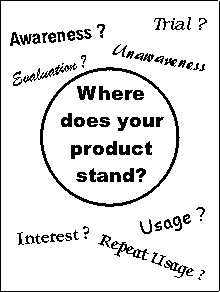
What makes us tick?
What are the driving forces that may urge a doctor to prescribe one product in preference to another? Among other factors, these include general human needs, as described by A.H.Maslow :
1. Physiological - Food and shelter
2. Safety - Security for home and work
3. Social - Need for supportive environment and social acceptance
4. Esteem - Status and having the respect of others
5. Self Actualisation - The need to realise one’s potential
On achieving one goal, the next goal is sought. Since marketing essentially involves satisfying customer needs, it is worthwhile to recognise that customer psychographics may be related to the hierarchy of human needs described by Maslow.
Incidentally, Maslow’s hierarchy of human needs is also linked to the motivational status of organisational staff - and this would include pharmaceutical marketeers as well.
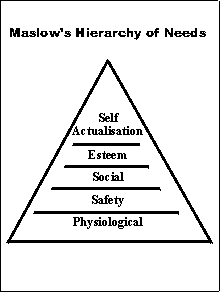
The Marketing Mix
Marketing involves 5 Ps : Product, People, Place, Price and Promotion.
Each of these in turn, encompass the following :
Product
Positioning
Features
Quality
Image
Packaging
Service
People
Salespersons
Doctors
-categories
-number
Trade
Place
Geographic location
Distribution
Outlets
Inventories
Sales territories
Price
Level
Sensitivity
Discounts
Promotion
Communication
Selling Strategy
Adverrtising
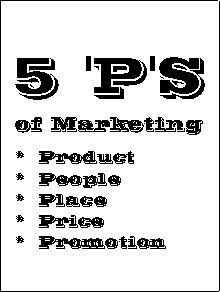
The Product Life Cycle
All products have a life cycle, going through the stages of Introduction, Growth, Maturation and Decline.
Stage 1 : Introduction
Slow growth may be due to lack of customer awareness. During this phase,
emphasis must be placed on achieving customer awareness, acceptance and
usage.
Stage 2 : Growth
Rapid acceptance is reflected in good sales growth and improvement in
profit.
Stage3 : Maturity
The product is well accepted but increasing competition slows down the
growth rate.
Stage4 : Decline
Competitors, including new molecules, capture customers. Decline can be
arrested or reversed by targeting new market segments, changing the product
positioning and advocating new uses.
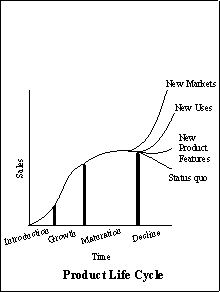
Stars, Cash Cows,
Question Marks
& Dogs
The Boston Consulting Group Grid helps to evaluate the product’s status and define priorities.
Stars
Products with a high market share in high growth markets. They need to
be strongly supported, because they represent the future.
Cash Cows
High market share in a low growth market. The strategy for these products
is to provide sufficient support to maintain market share and to use the
cash generated to support other products.
Question Marks
Small shares in high growth markets. These are undoubtedly problem products,
needing special attention and high investment.
Dogs
These have low shares in low volume markets. Pay minimal attention to
these products as they provide poor return on investment.
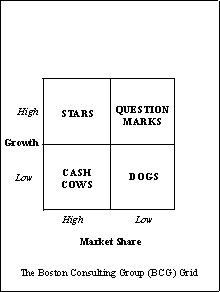
But what is a product?
To a customer, the product is a complex cluster of value satisfactions. It is not the same as the generic drug. Value is added in proportion to the perceived ability of the product to meet the doctor’s needs.
Generic Product
The generic product is the drug itself.
Expected Product
This represents the customers’ minimal expectations e.g., tablets in a
strip pack.
Augmented Product
The augmented product provides more than what the customer thinks he needs
or is accustomed to expect.The augmentations may be voluntary and unprompted,
and tend to educate the customer about what he can expect from the seller
e.g., special services. In time, customer expectations rise to what the
customer knows he can get. Augmentations are a means of product differentiation,
i.e., the difference that a customer will perceive in one product versus
another.
Potential Product
The potential product includes everything that can potentially be done
to attract and hold customers. While the augmented product represents
all that is already being done, the potential product involves what remains
to be done e.g., a new dosage form.
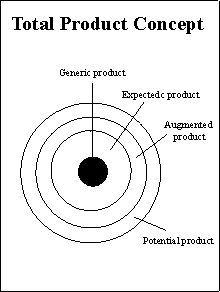
Positioning
Just as segmentation involves the decision to aim at a certain group of customers and not others, positioning involves a decision to stress only on certain aspects of the product, and not others. Thus the product position reflects the place the product occupies in the customer’s mind relative to other products.
The key idea in positioning is that the customer must have a clear idea of what the product stands for, and this is achieved chiefly through marketing communications, though other factors also play a role.
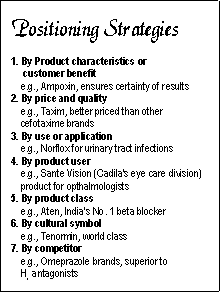
Products vs. Brands
The word “product” is often used synonymously with “brand”, but as we refine our understanding, we will appreciate a difference. In terms of the Total Product Concept discussed earlier, a brand represents the augmented product and more.
The brand includes a distinguishing name and/or symbol to identify and differentiate the goods or services from those of competitors. A brand name that is well known and liked by the customers has greater equity and is worth more to the organisation.
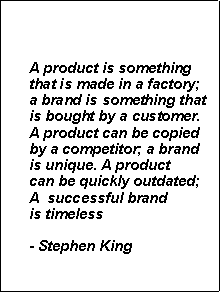
Brand Equity
Brand equity represents the value of the brand as an asset
to the organisation. A brand may have high equity, or value as a tradeable
asset, because it has
* Many loyal customers
* High level of awareness
* High reputation for perceived quality
* Associations which enhance the value of the brand
* Proprietary brand assets
Brand equity provides value to the customer by facilitating the customer’s relationship and understanding of the product, and in turn promoting confidence and satisfaction.
To the organisation, brand equity provides a competitive advantage, makes marketing programmes more effective, facilitates brand loyalty and provides scope for brand extensions.
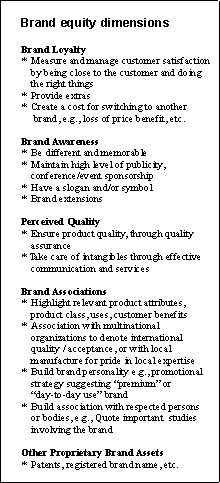
Brand Identity & Image
Communications to customers are aimed at giving the customer a clear idea of what the brand stands for. The message to be passed on to the customer must contain the key attributes, which would form the identity of the brand. Of these, attributes which are more central to the brand constitute the core identity, whereas others may form the extended identity. Obviously, it is crucial to first accurately define the brand’s identity.
What the customer perceives of the brand will constitute its image. Communication is aimed at obtaining a match between identity and image.The ultimate success in communication is when all the customers perceive the brand exactly as the marketeer has wished. But do we have any examples of that?
